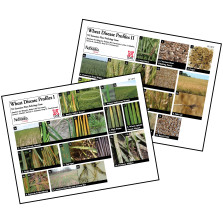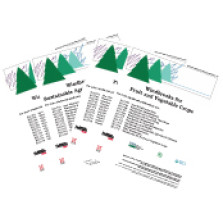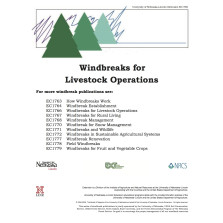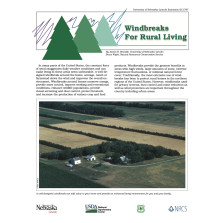Available filters Toggle display
- Category
- Book Cover Type
- Price
Publications
Need to be tax-exempt?
Contact Laura Tharnish before ordering.
ltharnish2@unl.edu or 402-472-1576
-

Wheat Disease Profiles
$2.00These Extension Circulars cover a variety of viral, fungal, and bacterial diseases affecting wheat and explain how to manage them.
Wheat Disease Profiles I, EC1873 contains descriptions and photos of wheat diseases, including viral, foliar fungal, and fungal root and crown rot diseases, plus brief management suggestions. Diseases covered include barley yellow dwarf, wheat soilborne mosaic, wheat streak mosaic, high plains disease, wheat spindle streak mosaic, stripe rust, leaf rust, stem rust, tan spot, septoria tritici blotch, common root rot and crown rot, and powdery mildew.
Wheat Disease Profiles II, EC1875 contains descriptions and photos of fungal and bacterial wheat diseases that affect heads and grain and/or leaves, plus brief management suggestions. Diseases covered include loose smut, common bunt (sticking smut), ergot, fusarium head blight (scab), take-all, stagonospora nodorum blotch, bacterial streak and black chaff, cephalosporium stripe, black head molds (sooty head molds), and black point.
Learn More -

Windbreaks and the Environment
$0.00Windbreaks reduce wind speed and create sheltered zones for growing crops and raising livestock. Windbreaks also protect living and working areas, and provide critical wildlife habitat in a landscape dominated by agricultural crops. This set of four Extension Circulars explains how to plant windbreaks to improve the local environment for wildlife, field crops, and fruit and vegetable crops.
Windbreaks and Wildlife (EC1771) provides an overview of how windbreaks can benefit wildlife and what trees, shrubs, and planting designs to consider for various wildlife habitats.
Windbreaks in Sustainable Agricultural Systems (EC1772) contains information on field, livestock, and farmstead windbreaks and how to integrate these with agroforestry practices to create sustainable agricultural systems that enhance the local environment and add profitability.
Field Windbreaks (EC1778) explains how field windbreaks can increase crop yields while reducing inputs and improving both environmental quality and production efficiency.
Windbreaks for Fruit and Vegetable Crops (EC1779) contains information on how wind affects vegetable and fruit crops and how to use windbreaks to improve growing conditions, yield, and quality of fruit and vegetable crops.
Format: One eight-page, one four-page, and two six-page Extension Circulars
Learn More -

Windbreaks for Livestock Operations
$0.00Windbreaks plan an important role in the protection of livestock, particularly in young animals and in areas with cold northerly winds during the winter and early spring. Properly designed and placed windbreaks can provide benefits to feedlots, liestock pastures, and calving areas. A well-thought-out and properly cared for windbreak protects livestock in both winter and summer.
Time spent on layout, site preparation, weed control, and replanting is paid back many times throughout the life of a windbreak. Topics covered in this guide include:
- Research-based information on how windbreaks benefit livestock, including cattle, swine, and sheep. Covers winter protection, summer protection, snow control, increased yields, working environment, screening unsightly areas, and wildlife habitat
- Designing Your Windbreak
- The Multi-Row Windbreak Design
- The Twin-Row, High-Density Design
-

Windbreaks for Rural Living
$0.00A well-designed windbreak around the home, acreage, ranch, or farmstead slows the wind and improves the overall environment. Windbreaks around homes conserve energy, provide snow control, improve working and recreational conditions, enhance wildlife populations, provide visual screening and dust control, protect livestock, and increase the productionof various crop and food products. Windbreaks provide the greatest benefits in areas with high winds, large amounts of snow, extreme temperature fluctuations, or minimal natural forest cover.
This six-page guide describes how to design a windbreak around a home, ranch, or farmstead to slow the wind, conserve energy, provide snow and dust control and improve working and recreation environments. It includes illustrations of sample windbreak layouts on a farmstead and considerations for design.
Learn More